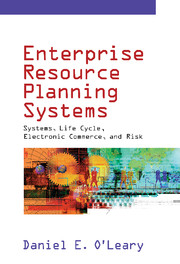Book contents
- Frontmatter
- Contents
- Acknowledgments
- PART ONE INTRODUCTION AND BACKGROUND
- PART TWO ERP SYSTEMS
- PART THREE ERP LIFE CYCLE
- 7 Deciding to Go ERP
- 8 Choosing an ERP System
- 9 Designing ERP Systems: Should Business Processes or ERP Software Be Changed?
- 10 Designing ERP Systems: Choosing Standard Models, Artifacts, and Processes
- 11 Implementing ERP Systems: Big Bang versus Phased
- 12 After Going Live
- 13 Training
- PART FOUR ELECTRONIC COMMERCE AND RISK
- Index
9 - Designing ERP Systems: Should Business Processes or ERP Software Be Changed?
from PART THREE - ERP LIFE CYCLE
Published online by Cambridge University Press: 05 June 2012
- Frontmatter
- Contents
- Acknowledgments
- PART ONE INTRODUCTION AND BACKGROUND
- PART TWO ERP SYSTEMS
- PART THREE ERP LIFE CYCLE
- 7 Deciding to Go ERP
- 8 Choosing an ERP System
- 9 Designing ERP Systems: Should Business Processes or ERP Software Be Changed?
- 10 Designing ERP Systems: Choosing Standard Models, Artifacts, and Processes
- 11 Implementing ERP Systems: Big Bang versus Phased
- 12 After Going Live
- 13 Training
- PART FOUR ELECTRONIC COMMERCE AND RISK
- Index
Summary
As part of choosing ERP software, firms face a design “reengineering policy” decision regarding the amount of software customization and organizational reengineering that must be done. On one hand, since no software is likely to meet all of a firm's needs, some firms have chosen to substantially customize the software to fit their processes. On the other hand, many businesses have used adoption of new software as a chance to change their basic business processes, reengineering their organization to match the “best practice” processes in the ERP software. In order to clarify the extent to which different firms pursue different policies, Forrester Research conducted a survey (Lamonica 1998) and found the following percentage of firms following policies:
choose applications that fit their business and customize a bit – 37%;
customize applications to fit their business – 5%;
reengineer business to fit application – 41%;
no policy – 17%.
This chapter analyzes two basic questions.
(1) How does the reengineering policy influence the software application choice process?
(2) Should business processes or ERP software be changed?
How Does Reengineering Policy Influence Software Choice Processes: On the Relevance of “As Is” and “To Be” Modeling
The decision to modify software or reengineer business processes (or both) influences the relevance and use of “as is” and “to be” modeling.
- Type
- Chapter
- Information
- Enterprise Resource Planning SystemsSystems, Life Cycle, Electronic Commerce, and Risk, pp. 117 - 140Publisher: Cambridge University PressPrint publication year: 2000

